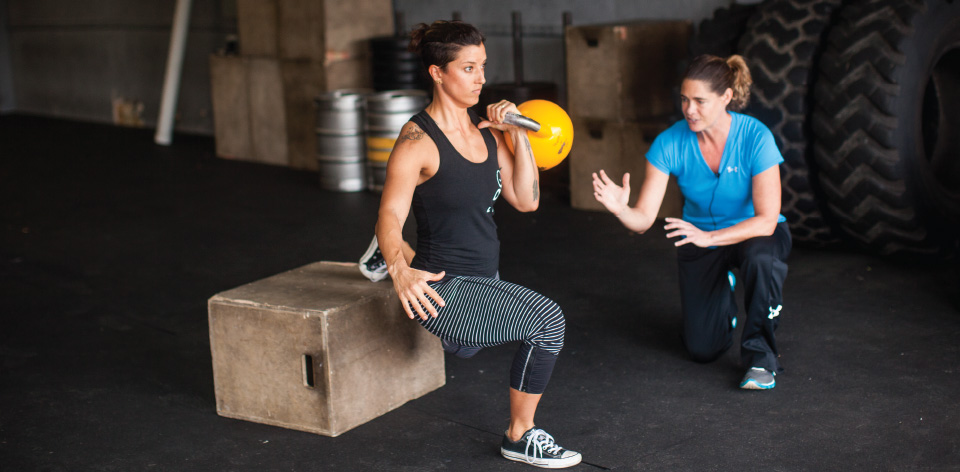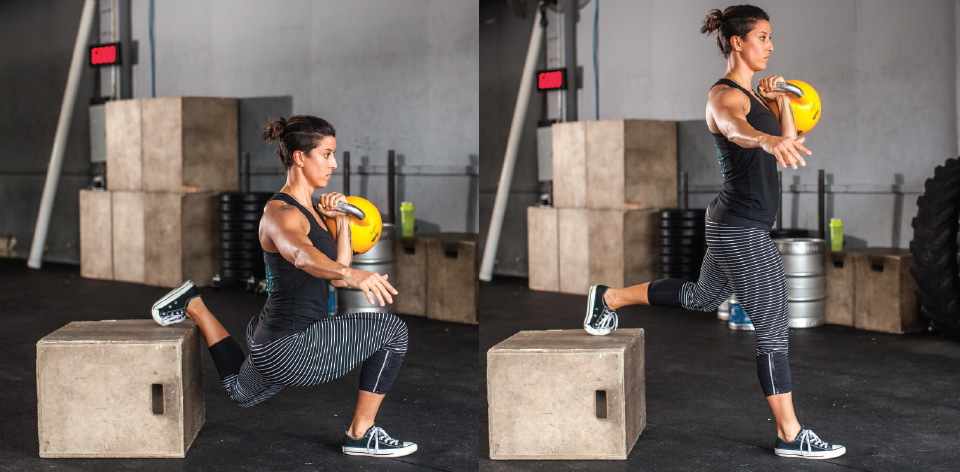Less Time, More Strength

Single leg strength and power are often overlooked in the gym. To be faster or increase your capacity to do more work in less time, you must make your movements more powerful. This assumes you are ready to load for higher levels of strength and power. It is not something we train for right out of the gate. We first must work on the foundation of general conditioning and basic strength.
Having said that, let’s take a look at a circuit strategy that allows us to take it up a notch.
A complex training set is defined as using a strength movement followed by a similar, explosive movement. This is a high intensity set, but by adding an active recovery movement, we allow active rest while still incorporating productive strength and stability work. When combined, the following three movements round out the complex training set. Crush it and have fun!
Lower Body Strength
Rear-Elevated Split Squat with One Arm Carry

Purpose: Emphasize strength in the single-leg stance and increase stepping and striding mechanics that positively influence speed and quickness. The extra challenge of loading with the opposite arm creates diagonal load and core stability demands.
Start: With one foot elevated behind you on a step or box. The box is used to maintain position and balance while shifting as much body weight on the forward foot as possible. The box height allows the torso to remain in an upright posture and not force an excessive forward angle.
Hold the kettle bell in one arm, opposite to ground-based foot, in a front carry position close to your body. Make sure the ground-based foot is aligned forward.
Use flexion of the ankle, knee, and hip (triple flexion) to lower the body into a single leg squat position. If looking from the side view, the mechanics should look the same as the two leg squat version.
Maintain a neutral posture with a long spine while descending slow and controlled.
Push through the floor with the ground-based foot to perform triple extension to return to start.
Tweak down: Perform a two-leg traditional dumbbell squat.
Tweak up: Perform a single-leg squat with no assistance from box or step.
Lower Body Power
Single-leg Box Hop

Purpose: Focus on the explosive take off of a single leg and land on a box to reduce impact stress at landing.
Start: Standing tall in a single-leg stance with a box in front of you that allows for a smooth take off and landing—usually just below knee height.
Perform a quick counter movement by using fast, partial triple flexion to load the power position.
Without holding at the bottom of the movement, perform an explosive hop onto the box. (This high intensity hop should have a quiet and controlled landing in a power, quarter squat position.)
Carefully step off hurdle to avoid impact loads in this set.
Tweak down: Perform a two-leg vertical jump onto a box that is below knee height.
Tweak up: Perform 3 consecutive hops together over 3 hurdles (instead of box) with the least amount of time on the ground in between the hurdles as possible.
Active Recovery Movement with Upper Body
Feet Elevated Push-Up to Pike

Purpose: A combination of strength movements that develop strength in the pushing motion as well as working mobility in the shoulder complex. The incline foot position places an increased amount of bodyweight on the upper body load—increasing the intensity of the movement as well as positioning the body for the pike. This is also a good way to practice getting used to an inverted (or handstand) position.
Start: In a push-up position with feet elevated on a box or bench. Hands should be at a width just outside the shoulders. Shoulders should be depressed and maintain the space between the ears and shoulders at all times through set up and movements.
Perform a push-up, return to the top of the push-up, then take small steps with the hands toward the box until the arms and torso are in line for the pike.
Hold the movement for a moment to establish control and good pike alignment.
Walk the hands back down to the push-up position.
Tweak down: Perform on the ground and walk hands toward foot position only as far as you can maintain a straight or neutral back.
Tweak up: Use a stability ball to create increased stability demands or add an external load by wearing a weighted vest.






